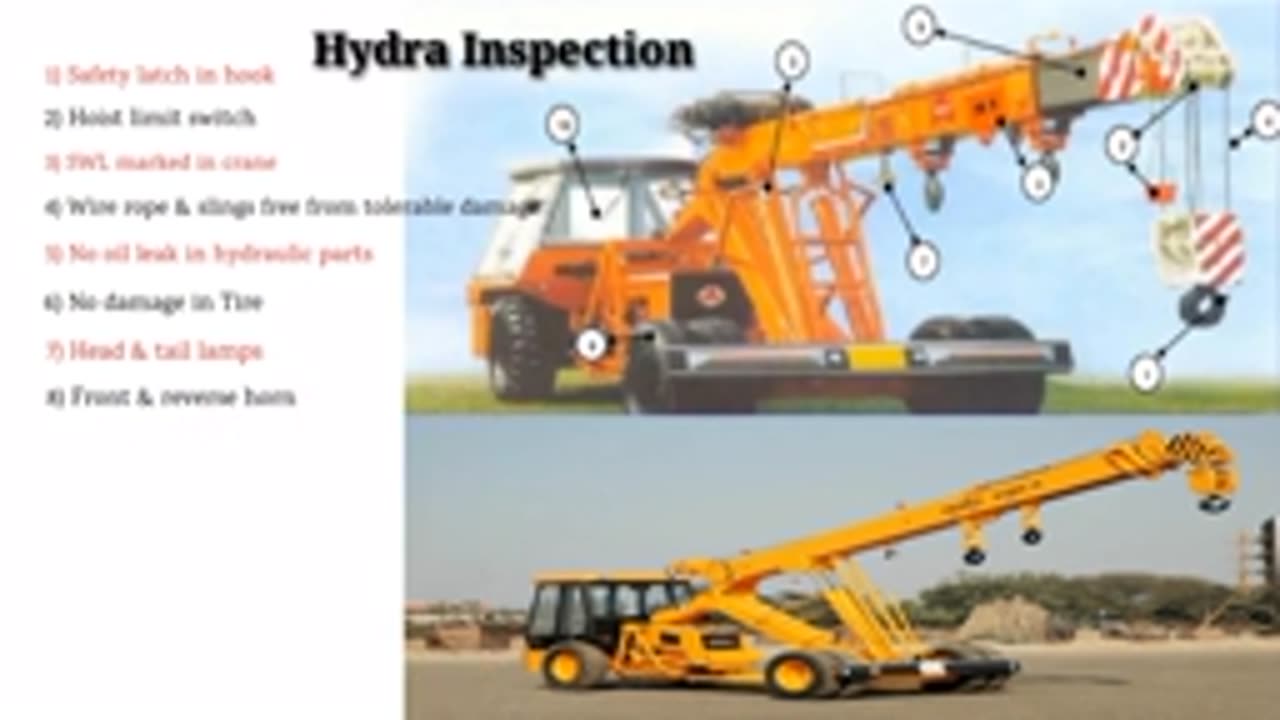Premium Only Content

How To Inspect Crane _ Hydra Crane _ Chain Sling _ Web Sling _ Wire Rope Sling _ HSE STUDY GUIDE
Here’s a structured **HSE Study Guide** for inspecting cranes (including Hydra cranes), chain slings, web slings, and wire rope slings. These inspections are essential to ensure safety, prevent accidents, and maintain compliance with health, safety, and environmental (HSE) standards.
---
## **HSE Study Guide: How to Inspect Lifting Equipment**
---
### **1. Crane Inspection**
#### **Hydra Crane**
1. **Pre-Operation Inspection:**
- **Visual Checks:**
- Inspect for leaks in hydraulic systems.
- Examine the boom for dents, cracks, or corrosion.
- Check tires, lights, mirrors, and controls.
- **Safety Features:**
- Verify operational condition of brakes, steering, and alarms.
- Ensure load charts and warning signs are visible and legible.
- **Load Handling Tools:**
- Inspect hooks for deformation or damage.
- Confirm that safety latches are functional.
2. **Operational Tests:**
- Test all hydraulic controls and movements (extension, rotation, and lifting).
- Verify that the overload protection system is functioning.
3. **Periodic Maintenance Inspection:**
- Check the condition of hydraulic oil, hoses, and cylinders.
- Test the structural integrity of the frame and joints.
---
### **2. Chain Sling Inspection**
1. **Initial Visual Check:**
- Inspect links for signs of wear, elongation, or distortion.
- Look for cracks, gouges, or nicks on the chains.
2. **Measurement and Criteria:**
- Measure chain links to ensure they meet manufacturer specifications.
- Replace the chain if wear exceeds 10% of the original thickness.
3. **Hooks and Attachments:**
- Check hooks for bending or cracks.
- Ensure that latches are functional and secure.
4. **Markings and Identification:**
- Ensure all identification tags (e.g., load capacity, manufacturer) are legible.
- Remove from service if tags are missing or damaged.
---
### **3. Web Sling Inspection**
1. **Surface Inspection:**
- Check the sling for cuts, tears, abrasions, or fraying.
- Look for signs of heat damage (melted fibers or discoloration).
2. **Edge Protection:**
- Ensure that wear pads or sleeves are in place for sharp edges.
3. **Stitching and Load Labels:**
- Inspect the stitching for loose or broken threads.
- Verify that the load rating label is legible and accurate.
4. **Replace If:**
- There is visible damage to more than 10% of the surface fibers.
- The sling shows signs of chemical degradation (e.g., stiff or brittle fibers).
---
### **4. Wire Rope Sling Inspection**
1. **Visual Inspection:**
- Look for broken wires, kinks, bird-caging, or corrosion.
- Check for wear or flattening in critical areas (e.g., near the eye or load points).
2. **Wear and Tear:**
- Replace if the number of broken wires exceeds the standard (e.g., 10 in one lay or 5 in one strand).
- Inspect for reduction in rope diameter due to wear or core damage.
3. **End Fittings:**
- Examine end attachments (thimbles, hooks, or clips) for cracks or deformation.
- Ensure splices or swages are secure and intact.
4. **Lubrication:**
- Check that the rope is properly lubricated to prevent corrosion.
- Reapply lubricant if necessary to maintain flexibility.
---
### **5. Inspection Frequency**
- **Daily/Pre-Use Inspection:**
- Conduct a thorough visual inspection of all equipment before each shift.
- **Periodic Inspection:**
- Performed monthly or quarterly by a qualified inspector.
- Ensure compliance with manufacturer guidelines and HSE standards.
- **Annual Inspection:**
- Conducted by certified personnel to assess structural integrity and replace worn components.
---
### **6. General Safety Guidelines**
- **Remove Damaged Equipment from Service:**
- Tag equipment as "Out of Service" if defects are found.
- Follow proper disposal procedures for unrepairable items.
- **Load Limits:**
- Never exceed the specified load capacity.
- Use the correct equipment for the weight and type of load.
- **Storage:**
- Store slings in a dry, cool place away from chemicals or UV exposure.
- Avoid tangling or overlapping slings during storage.
- **Training and Certification:**
- Ensure all operators and inspectors are trained and certified for the equipment.
- Conduct regular refresher training on inspection and safe handling practices.
---
### **7. Record Keeping**
- Maintain detailed records of all inspections, repairs, and replacements.
- Include the following in records:
- Date of inspection.
- Name of the inspector.
- Equipment serial number or identification.
- Observations and corrective actions taken.
---
Would you like a printable checklist or a visual guide for these inspections?
-
 LIVE
LIVE
The Mel K Show
1 hour agoMORNINGS WITH MEL K - Reexamining the US relationship with International Banks, Treaties, and NGOs 8-27-25
662 watching -
 LIVE
LIVE
The Shannon Joy Show
3 hours ago🔥🔥SAVE Baby Kit! Hospital Injects 2 Pound Baby With Hep B Vaccine Without Mom’s Consent, Injures Him Severely Then Calls CPS On The Family!🔥🔥
186 watching -
 LIVE
LIVE
Viss
1 hour ago🔴LIVE - Improve Your Battle Royale Play with Tactics & Strategy! - PUBG
152 watching -

Grant Stinchfield
3 hours agoBallot Harvesting Scams EXPOSED: Dead Voters, Fake Signatures, Real Crimes
6.8K1 -
 1:01:40
1:01:40
VINCE
3 hours agoThe Democrats' Ticking Time Bomb | Episode 112 - 08/27/25
173K121 -
 LIVE
LIVE
JuicyJohns
4 hours ago $0.42 earned🟢#1 REBIRTH PLAYER 10.2+ KD🟢
49 watching -
 LIVE
LIVE
LFA TV
6 hours agoLFA TV ALL DAY STREAM - WEDNESDAY 8/27/25
5,058 watching -
 LIVE
LIVE
GloryJean
3 hours agoAggressive Solo Gameplay on Mouse & Keyboard 🖱️ 6.7 K/D
29 watching -
 LIVE
LIVE
The Pascal Show
2 hours ago $0.11 earnedBREAKING! Mass Shooting At Annunciation Church In Minneapolis Multiple Shot
39 watching -
 1:43:04
1:43:04
Dear America
4 hours agoNo More IRS!! Tariffs Bring In Over $500 BILLION! + Taylor Swift Got ENGAGED… This Is A Nightmare!!
105K78